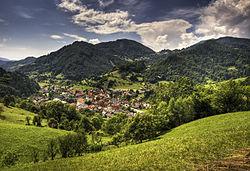- Cerkno
-
Cerkno — Town and Municipality — Location of the Municipality of Cerkno in Slovenia Location of the Town of Cerkno in Slovenia Coordinates: 46°8′23″N 13°58′16″E / 46.13972°N 13.97111°ECoordinates: 46°8′23″N 13°58′16″E / 46.13972°N 13.97111°E Country  Slovenia
SloveniaGovernment - Mayor Jurij Kavčič Area - Total 131.6 km2 (50.8 sq mi) Population (2002)[1] - Total 5,040 - Density 38.3/km2 (99.2/sq mi) Time zone CET (UTC+01) - Summer (DST) CEST (UTC+02) Website cerkno.si Cerkno (Italian: Circhina, German: Kirchheim) is a small town and a municipality in the Littoral region of Slovenia.[2] It has around 2,000 inhabitants and is the administrative centre of the Cerkno hills. The municipality has around 5,000 people.
It is known for the Laufarija carnival, a spring festival with carved wooden masks;[3] for the Franja Partisan Hospital (Partizanska bolnica Franja), a partisan hospital from World War II and as a ski resort.[4]
Cerkno is a small but important local cultural center in the Goriška Region near Idrija. The town and its surroundings were the birthplace of many famous Slovenes including Archbishop of Gorizia Frančišek Borgia Sedej (1854–1931); writer France Bevk (1890–1970); photographer Rafael Podobnik; historians Milica Kacin-Wohinz and Boris Mlakar as well as politicians Marjan Podobnik and Janez Podobnik.
The Parish Church in the town is dedicated to Saint Anne and belongs to the Diocese of Koper. A second church in the settlement is dedicated to Saint Bartholomew.[5]
Contents
History
Historically, the Cerkno hills belonged to the Tolmin County. In the 16th century, the area came under Habsburg rule, and was included in the County of Gorizia and Gradisca. After the end of World War I, the area was occupied by the Italian Army, and officially annexed to Italy in 1920. Between 1920 and 1943, it was part of the administrative region known as the Julian March. After the Italian armistice in September 1943, Cerkno was liberated by the Yugoslav Partisans, and became one of the most important centres of partisan resistance in the Slovenian Littoral. In 1945, it came under Yugoslav military administration, and in 1947, it was officially annexed to the People's Republic of Slovenia within the Federal People's Republic of Yugoslavia.
See also
References
External links
Cerkno Settlements Administrative centre: Cerkno
Bukovo, Cerkljanski Vrh, Čeplez, Dolenji Novaki, Gorenji Novaki, Gorje, Jagršče, Jazne, Jesenica, Labinje, Lazec, Laznica, Orehek, Otalež, Planina pri Cerknem, Plužnje, Podlanišče, Podpleče, Poče, Police, Poljane, Ravne pri Cerknem, Reka, Straža, Šebrelje, Travnik, Trebenče, Zakojca, ZakrižNotable people Landmarks Categories:- Populated places in the Municipality of Cerkno
- Municipalities of Slovenia
Wikimedia Foundation. 2010.



